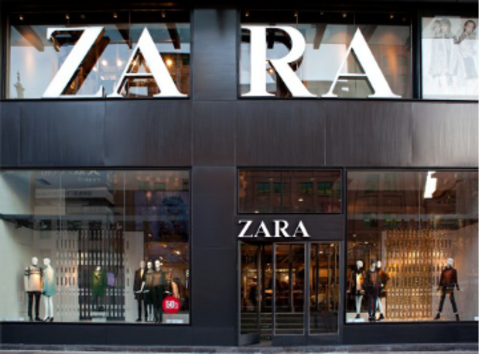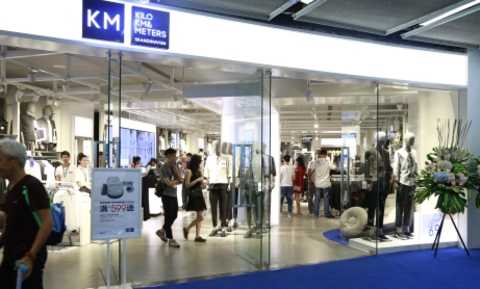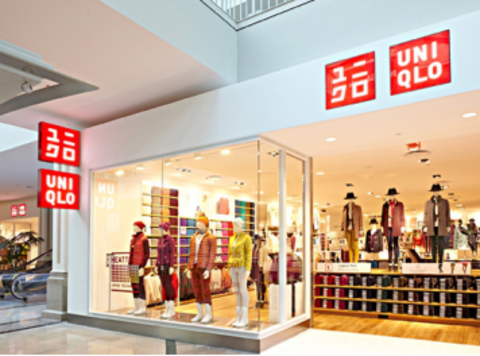Fast fashion has always been the limelight, and despite all the sings, it still shows beautiful sales transcripts. The concept of fast fashion has long been familiar: how fast and better! The surface looks like this, but it is not. ZARA, KM, H&M, and Uniqlo seem to have never stopped expanding. All the way forward, continuous expansion and profitability are common to several companies. What are the business methods behind the four fast fashion brands? ZARA The fast fashion king ZARA, the most powerful, most successful and most stable fast fashion brand among the four brands, has been imitated and never surpassed. ZARA's brand core competitiveness is currently not imitated by all fashion brands in the world. Not to mention the scale, after all, it is possible for everyone on the scale, here is to emphasize its non-replicable model. The model adopted by ZARA is called Vertical Integration and is shipped vertically. Greatly shortened shipping time: an average of 2 weeks, so the fast fashion brand represented by ZARA can have 15-20 Collections a year. In contrast, the entire process of ordinary brand shipments takes 4 to 6 months, and there are generally only two Collections per year. However, thanks to the Vertical Intergation model, ZARA is able to control the entire process better (from market research, to design, boarding, sample making, mass production, transportation, retail) than other fast fashion brands. H&M, known for its speed of shipment, is five days faster. In pursuit of speed, ZARA sacrifices a lot of costs: 1, local production, near the fast In the production process, ZARA relies on the numerous hand-made workshops in La Coruna, where the headquarters is located. Many home products are produced locally. Until recently, they were gradually outsourced. However, H&M had 75% of products in Asia in previous years. Manufacturing, now all production has been outsourced. However, for this reason, H&M's price is about 50%-70% of ZARA (not considering raw material costs for the time being) 2, prefer to pay high transportation costs All long-distance transportation is an airplane, not a cargo ship. It is willing to pay a high freight rate and is not willing to spend advertising and marketing expenses. ZARA's marketing expenses only account for 0.3%-0.4% of the total cost. However, other brands are big. About 3%-4%. Even if it costs a lot of money to pursue fast, ZARA's gross margin and net profit margin are still comparable to H&M, and ZARA is not willing to save the above costs in order to increase profit margin. Therefore, ZARA seems to be a fashion brand, but in fact it is more focused on production and retail, and also benefit from this, ZARA can reach all fashion brands and retailers unprecedented height: 1 ZARA headquarters warehouse will not stay more than three clothes In the day, the store will place an order twice a week to replenish the product at the headquarters. The inventory turnover rate is 3-4 times higher than other brands; 2, on average, only 15% of the clothes need to be sold at a discount, while other brands are 50%. 3. The average customer goes to ZARA 17 times a year, and the other brands only have 4 times. ZARA's quickness is also attributed to their "reverse" design concept. The store provides the sales data, and then submits it to the store manager. After the store manager finishes the work, the result is handed over to the design department. The design part is designed according to the customer's needs, and then submitted to the commercial department to evaluate the cost and price. The board, the sample production, was handed over to the factory for production, and finally stored in ZARA's super large logistics warehouse (9 times that of Amazon). There are countless trucks at the warehouse door to transport the products to other parts of Europe or the airport twice a day. In this process, in terms of design, an average of 20 minutes to design a piece of clothing, can design more than 25,000 new models each year, 4-6 times that of H&M. Because the customer's demand for fashion is changing, the information collected from the store is time-sensitive, so it is the most fundamental and important magic weapon for this model. It is precisely because ZARA is a maverick model that makes the rest of the existing brands completely impossible to emulate, because if it is emulated, it means that the designers of the brand no longer play a decisive role in the design, and even need to rebuild the designer team, the logistics system. , production process and so on. There are advantages and disadvantages, and the drawbacks of the ZARA model are also obvious: 1. Because of the control of the entire process, the operational risk is increased. If there is economic decline or industry downturn, it is impossible to transfer the pressure to the supplier (for example, asking the supplier to cut the price) 2. It is impossible to integrate the advantages of each country and maximize profits. 3. The store is directly managed by the brand and cannot be rapidly expanded through agents (such as Benetton in Italy), and some of the property needs to be invested in the renovation and renovation of new stores and existing stores, reducing the asset turnover rate. As everyone knows, the problem of plagiarism, ZARA has been clearly copied for many years, you tell me, the lawsuit will lose you money, anyway, I can earn it back (unlike the United States Forever21 was accused after a lot of rumors) In short, ZARA creates a new business model, a business model based entirely on customer needs. Therefore, ZARA's current enemy is only its own. Only by fully understanding and controlling the pros and cons can we achieve long-term stable and sustained development. KM KM, a word to describe the brand is: too fast! This fast not only refers to the rapid development of the fast fashion industry, but also refers to the speed of the rise of the fashion industry's rookie, the speed of expansion is really staggering fast, the industry is full of curiosity about the brand's rapid popularity, and because of this KM, whose history is relatively short, can be regarded as the king of the topic of fast fashion. 1. Seize the young market. From the design point of view, KM does not copy big cards like ZARA, do cheap and luxury, and does not make basic models like UNIQLO. The overall product is fashionable but converging. The basic and design models are roughly divided into 8:2 ratios, especially among the four fast fashion brands to be discussed. 2, C-end guidance, deepen user needs. KM's products add a sense of design that can be felt in the simplest, bringing more aesthetics to the millennial generation with higher aesthetic requirements, but at the same time not overriding, not challenging the entire male dressing environment for many years. The sense of security, this subtle user experience directly represents the style of KM. Thanks to this seemingly subtle user analysis, once launched, KM quickly gained the support of young consumers who are seeking new and different. However, in the fast fashion field, the global buyer system is not unusual, with a senior team control field, plus enough talent resources investment and management, the global buyer model is not too difficult to operate. 3, no winning, tricks, interaction, absolute innovation. Perhaps the most worthwhile study of KM is not the product, but the routine that he does not rely on the routine. How to understand this sentence? The pattern is too wide, the road is too wild, and it is not downright. Using the in-house standards can't predict the next step of the brand. Sometimes you can see the internet brand's gameplay in the brand's operation, such as the massive media platform of fans, and the interactive marketing between young people. Among the four brands discussed in this discussion, KM is definitely the fast fashion brand that attaches the most importance to fan operations. For example, membership and community, these are the usual ways of e-commerce and micro-business. The fast-fashion field itself is very late in accepting e-commerce. KM does not quickly embrace e-commerce, but on the other hand it is active. It’s really hard to understand when you play the community. Everyone wants to know what he wants next. KM is worthy of being the king of the topic in fashion. If you want to summarize the number of brands, it is not limited and innovative. Starting from the brand and ending with the user, there are countless possibilities for this road, but every time innovation, the consumer will scream once more and gain more market love. H & M H&M, in terms of mode, is more inclined to take into account the shipping time and product cost, so the speed is not as good as ZARA, and the fashion level is not as good as ZARA, but it also has a place in this industry relying on cost leadership. H&M is the first choice for young people in Europe. The recent design is on the street, big prints, denim, big letters, big camouflage, etc. The shortcomings of the products are also obvious, the quality is not flattering, and the fabric is the worst in the four brands. But like ZARA, it is the innovator who transforms clothing from durable consumer goods to fast moving consumer goods, so quality is less important. Among them, H&M's most colorful place is a sportswear. This series is not sold in China. It is estimated that people do not like sports in China. In fact, H&M's sportswear is very professional, the classification is very fine (running, tennis, and even yoga), the price is cheap, not cheaper than Adi Nike, so it is very popular, sales are very good. The Replenishment Rate of H&M sportswear reached 36% in 2013, and only 10.4% of the discounted sales (ZARA's inventory turnover rate is so high and 15% need to be sold at a discount), compared to sportswear is definitely H&M. A big highlight. On the other hand, H&M has more choices in the choice of size, and there are even many that are tailor-made for mothers. The picture below shows the comparison of the UK's H&M's additional size statistics with the major local brands: Therefore, it can be said that H&M and ZARA are each satisfying customer needs in different aspects, the former is in daily wear and use, and the latter is in design. In terms of operations, H&M focuses on low cost, and ZARA focuses on product update speed. UNIQLO The last one, Uniqlo. Cheap, comfortable, high quality fabrics, simple style and easy to match, and later added UT series. If you want to say the core competitiveness of Uniqlo, there are several items that have to be mentioned: 1, fabric: This has something to do with the history of Uniqlo. It was all over Japan and still launches a new fleece jacket every autumn and winter, so that Uniqlo tasted the sweetness brought about by the fabric. Since then, Uniqlo has been innovating in the use and research and development of fabrics, such as A wool farm in Inner Mongolia, which specializes in feeding fabrics to Uniqlo, and the lightweight Heattech series of thermal underwear, are the products that Uniqlo is constantly pursuing for high-quality fabrics. 2. Service: I don't need to say much about this. A friend of mine used to work in Uniqlo. All the customers who passed by you would like to say hello. The single request for greeting customers is not comparable to other brands, and other services can be experienced. 3. Details: Like MUJI, the details of the store are extremely demanding, and the way all the clothes are stacked is very particular. For example, it is easy for customers to see the wide folding of the trouser legs. Another detail I have to say, I believe many people have neglected, it is the mirror. In the country, the mirrors of Uniqlo are completely different from the mirrors of KM, H&M and ZARA. Part of it is due to the placement of the mirror and partly because of the light. Because the contours of the yellow people, especially the contours of the face are not deep, they are more "flat" than those in Europe and America. Therefore, the yellow people are not suitable for the effect that the light is directly shot from above, which will pass the defects of the facial contour. The shadows are fully revealed, but the deeper Europeans can show the three-dimensional skeleton. Therefore, when looking in the mirror, the light is slanted from the front or the back and is more suitable for the yellow race. At the same time, the choice of lighting is just right, not yellow, not glare, soft light, can make up and even beautify the skin. 4. Process: The sewing stitches of Uniqlo's shirt craft chest bag are completely the technical requirements of the suit. This detail has been requested. Is there any reason to question the craft of Uniqlo? 5, UT series: The T-shirt is the simplest and direct way to convey culture and art. The UT series is a collaboration with artists. The art-pattern is displayed directly on the T-shirt, restores the original role of the T-shirt, and sells cheap products. The taste of a piece of art. The business stock is limited, and I want to continue to occupy my own share in the Red Sea. The way of running fast and fashion is different. There is no chance to ask fast fashion, there must be. To ask how to do it? On the one hand, to find differentiation, on the other hand, still pay attention to the brand's own genes, to be yourself, to maximize the brand's natural advantages. The essence of business is that it has to be different, there is no winner forever, only continuous iteration can be king. Editor in charge: Liu Bing
With 3 factories, options for material fabrics are from yarn size 40s to 120s, thread count ranges from 200TC to 1000TC and patterns include plain, satIn, satin stripe, grid and jacquard for you to choose.
Our main products are: Hotel Towels,Hotel Face Towel ,Cotton towels Shaanxi Xiaoze Textile Co., Ltd. , https://www.xtsxxzth.com



1. Hotel bedding fabrics
2. Hotel duvet covers, bed/flat sheets, fitted sheets, pillowcases
3. Hotel duvets, pillows, mattress protectors, mattress toppers
4. Face towels, hand towels, bath towels, bath mats, slippers and hotel bathrobes